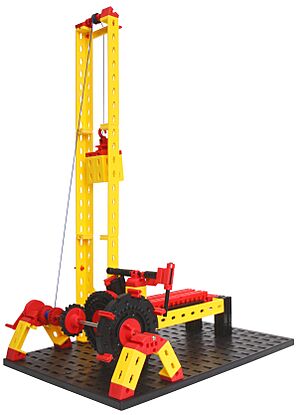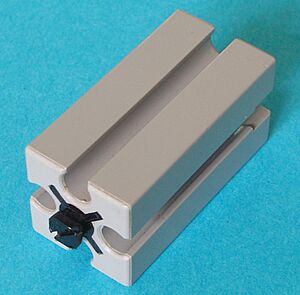Fischertechnik facts for kids
| Type | Construction set |
|---|---|
| Inventor(s) | Artur Fischer |
| Company | fischertechnik GmbH |
| Country | Germany |
| Availability | 1966–present |
| Slogan | Building blocks for life |

Fischertechnik is a super cool brand of construction toy. Artur Fischer invented it, and a German company called fischertechnik GmbH makes it in Waldachtal, Germany. Fans often call it "FT" for short.
Fischertechnik is used in schools to teach about simple machines, how things move, and different mechanisms. The company also offers computer parts. These parts help you learn about robots and how machines work automatically.
Contents
The Story of Fischertechnik
How Fischertechnik Started
Fischertechnik began with a German company that made fasteners. The very first Fischertechnik set was a special Christmas gift in 1964. It was given to engineers and buyers at big industrial companies. People loved these gifts so much!
Because they were so popular, the company decided to sell building sets to everyone for Christmas in 1965. One reason for creating these toys was to help young people get excited about technology and science. By around 1970, you could even find these construction sets in fancy toy stores in the United States, like FAO Schwarz.
Building with Fischertechnik
The Basic Building Blocks
The main building blocks of Fischertechnik have a special channel-and-groove design. They are made from strong nylon plastic. The most common block sizes are 15×15×15 millimeters and 15×15×30 millimeters.
Each block has a peg on one side. This peg can fit into a channel on any of the other five sides of a similar block. This creates a very strong connection. You can build almost any shape you can imagine! Red plates can be added to cover the outside of your models, making them look complete.
Cool Accessories and Parts
The first blocks were usually gray, with red parts like wheels and angled blocks. Soon, electric motors, power sources, and gears were added. These parts let you make your models move!
Other building pieces, like long struts, were added in "statics" sets. These sets let you build realistic bridges and tall tower cranes. Some Fischertechnik beams are even made of real aluminum. You could also find companies that made custom aluminum bars that fit Fischertechnik.
Some sets even included measuring tools. This allowed you to learn about physics by calculating and testing how forces work in your models.
Smart Electronics and Robots
Adding Electricity and Electronics
Early Fischertechnik sets were very advanced. Engineers often used them to teach and create models of industrial robots. More electrical and electronic parts were added to help with this. These included tiny switches, magnetic sensors, and light sensors (photocells). These parts could sense positions and send information to motors.
There was even a special "basic electronic block" (called Grundbaustein). It had parts that let you build circuits that could make decisions or create delays. In the late 1970s, electronic logic parts were introduced. These "logic gates" (like AND, NAND, OR, NOR, and flip-flops) allowed models to make simple choices. Parts that used air pressure (pneumatic devices) were also added to give models gripping abilities.
By the late 1980s, special computer modules were included. These allowed you to program a sequence of movements for your models. The first software used for this was called "Lucky Logic" (LLWIN).
Robots and Computer Control
By 2006, Fischertechnik offered sets for controlling robots using "Robo-pro" software. This was an improved version of Lucky-logic. These sets included computer controllers with memory, remote controls that used infrared or radio waves, and parts that used air pressure.
Robotic models could follow paths or lines on the floor. They could sense things in their way and change direction. They could also pick up and move objects. You could even build models that acted like everyday machines, such as vending machines, elevators, or traffic lights. In early 2010, Fischertechnik released the ROBO TX Explorer kit, which came with a color sensor.
Different Types of Sets
A Look at Fischertechnik Sets Over Time
Fischertechnik has made many different sets over the years. The company has also changed the names of existing sets several times. There have been as many as five different series of these sets. Fans often call them "A", "B", "C", "D", and "E". These series had similar but slightly different parts, though all parts could be used together.
These series roughly fit into different production years: 1967–1971, 1972–1975, 1976–1981, 1981–1984, and 1984–1991. For example, the "A" series boxes mostly showed black-and-white pictures. The "B" series boxes had a special "Oscar DuJouet 1970" award sticker. The "C" series introduced black plastic gears (before that, they were all red). The "D" series brought in yellow plastic "statics" parts (which used to be gray).
Modern Fischertechnik Kits
More recently, Fischertechnik has started making many kits designed for building specific models. These include boats, airplanes, bridges, and cranes. This is a bit different from their older style, where they made general sets that could be used to build hundreds of different models. Fischertechnik also now offers advanced robotic sets. These sets come with battery packs, remote controls, and programmable control boards.
See also
- Lego Technic


